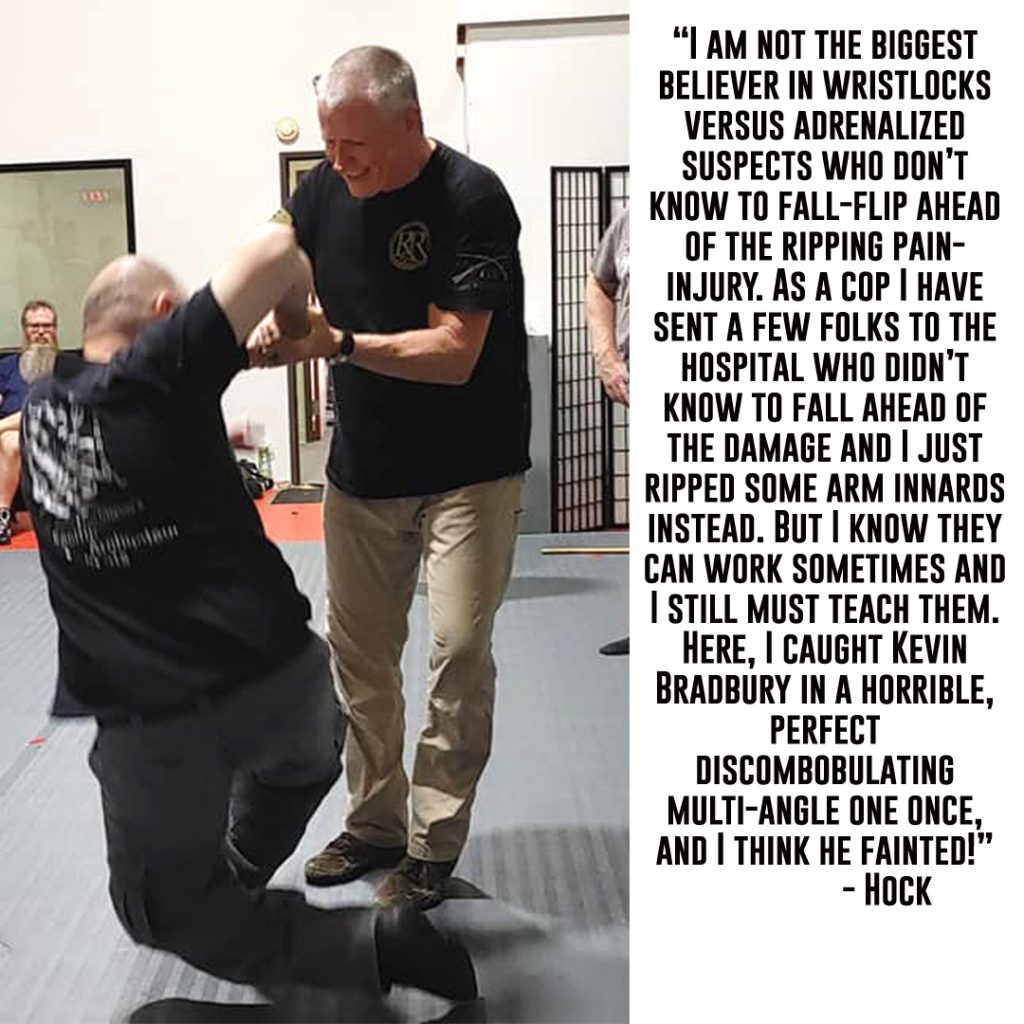



An Orderly or Tactical Retreat, (safely walking or running away!) Stay or retreat? A retreat has several definitions, like “retrograde” movements or a more modern “tactical retreat.” Usually, these definitions suggest that one retreats from a superior force in battle. Military. In today’s civilian world, remaining to fight and take action, may become a physical, legal (criminal law and civil law) nightmare and monetary problem. Winning and the law are often at odds.
Whatever the terms, retro, orderly or tactical, it still means you leave, escape, withdraw, whatever, with the best plan to do so. For a smaller, personal situation an orderly retreat is leaving a confrontation, safely and without being chased, at all, or much.
“Just run away!” these pseudo experts will say. But, just how far can you run? How fast? How long?
The law will ask, if there’s trouble, why did you go there and why are you still there? Can you leave people behind? Will you be leaving family, friends and comrades behind? Can you leave? Should you leave? Sometimes you can’t leave. Your choice is highly situational. Think of any violent situation from a fistfight to a crime, to an active shooter, on to war and ask these questions about staying or leaving?
How exactly will you retreat? If you stay, there will be violence. If you go? Best go in an orderly fashion. When you add the term “orderly,” it speaks of significant specifics. What is this “orderly” version? An orderly retreat?

In his beginning battles he had some large causalities usually from chaotic retreats. When his troops hit their perceived “breaking point,” hey turned and they scattered, most were killed from behind, running in disorderly retreats. Long known, psychological factors reveal that it is easier to “kill from a distance” and to “kill from behind,” without seeing a person’s face, without seeing a “personality.” (This relates to crime also.) Then, Alexander adopted he Macedonian 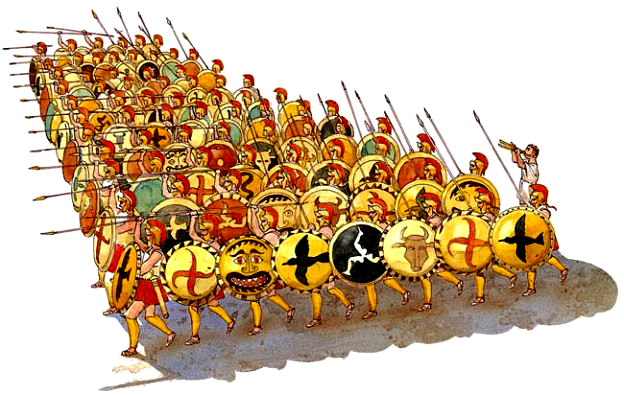
Simply turning and running away, sounds like good advice, but how far and fast can you run, and such may make you easier to be killed, and may ignite an anger, and/or ignite a hunter-chase mentality in a criminal or a enemy soldier. Departing, withdrawing as smartly as possible is better choice.
Turning and leaving. In the martial word, just turning from a too close opponent standing or down on the floor-ground, is “giving up your back” and means something specific to martialists – exposing your back is an invitation to be choked. In crime and war your turned back make you easier to be beaten, captured or be killed. When you turn to leave, it should be done by first backing away in some manner to a safe distance and then turning to leaving.
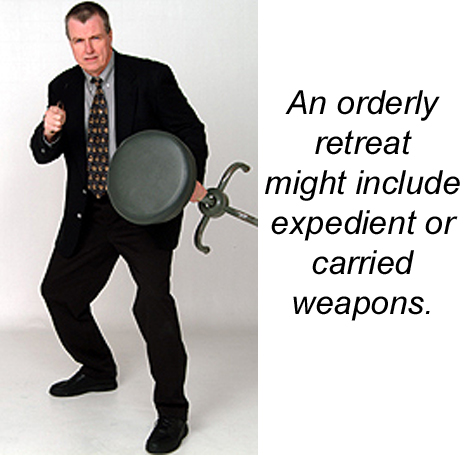
If no physical contact is made yet, we are still in the Stop 1 parameters and leaving the projected fight scene before it starts, is a quintessential Stop 1 situation-problem. But the option to leave may occur in any of the Stops, Stop 2 through Stop 6.
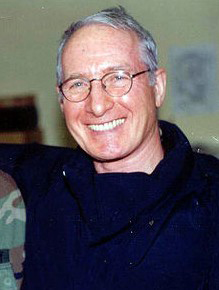
“Hock, sometimes you gotta’ blow the horn,” (the horn being thetrumpet of retreat.) “Always have a go-to hell plan, and another one when that one goes to hell too.”
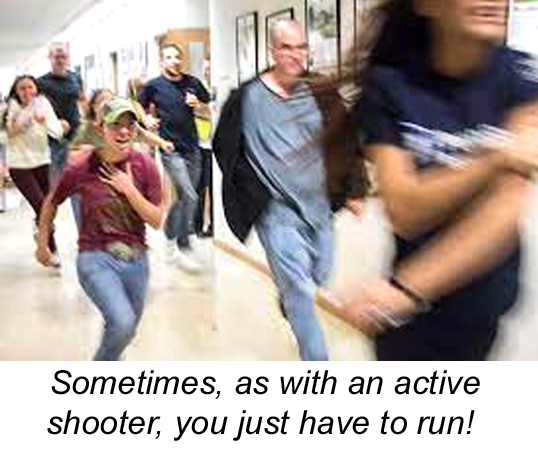
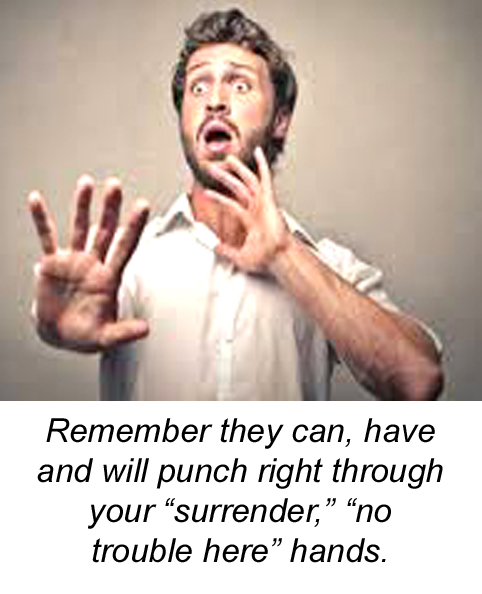
There is no one way to prescribe any one universal orderly retreat, but it is important to understand the concept, teach the idea, and develop and practice some real, “go to hell,” plans.
___________
Watch some free, full training films on Hock’s TV Channel! Click here…
The mistake? Ignoring the successful moves. I could write a ton about this point and its unintended after-effects in hand, stick, knife, gun survival training and related, muscle memory. But, I’ll just leave this shorter essay here.
The specific point of this is about misguiding mission, misguided training doctrine. This is about the training ignorance, the naivete of people – students and instructors, not to recognize this. Failing to recognize the devastating, simulated, tactic-technique, failing to “blow the whistle” and say,
“STOP! Okay, George, you probably won that one!”
This is a doctrine problem in any system, stick fighting, knife fighting. Any one. For one example, two stick-fighting guys bash each other’s helmets in, yet the fight ends with a grounded submission hold or choke? Nope, that fight ended 80 seconds earlier. Think about that. I have seen a lot of floor tap-outs by partner A on partner B, yet B had actually won that hand, or stick, or knife fight a minute earlier, first standing or maybe on the ground, simulating doing something vital-devastating, that was-
Not recognizing this point, not rewarding this “winning move,” makes for incorrect, off-mission, survival doctrine and bad muscle memory. But listen, this is just fine for sports, arts, hobbies, exercises and fun, in which case it is NOT a terrible mistake. Know what you do and what you want. Know your mission. Stay on mission.
__________________________________________
Hock’s email is HockHochheim@ForceNecessary.com
Check out all these martial books, click here
The rituals of death. Understanding them may save your life. But, when you try to research the term, all you are most likely to uncover are after-death, practices of various worldwide religions and funerals, like tossing a handful of dirt on a coffin to name but one. I guess the trouble with the research quest is the word “ritual” – so quickly associated with religions. Dig a bit deeper (no pun intended) and you’ll find a few ceremonial pre-death rituals like when archaeologists discovered that the Incas got their children sacrifices drunk before their deaths on coco leaves and alcohol. Still after much digging, not much is mentioned about before the death.
If you broaden your own the definition of “rituals,” of death, it starts you thinking. You might recall the many other kinds of political and religious killings, ones before the flame, the shot, the needle, the hanging, the guillotine, the firing squad, the electrocution, etc. We remember some pre-death, rituals with them. Before such events, we have been exposed to ritualistic habits like, “the last meal.” The “last cigarette.” The blindfold, “any last requests?” “any last statements?” These are also rituals of death, before the act. Why do people bother with them?
Think about the ritualistic procedures in the United States over a prisoner execution. There are many ritualistic steps and protocols. Think about how people reluctantly gather in to witness the execution. In the olden days, people gathered for the public hangings, nowadays seating is assigned at the prison death chambers to watch a person die. I feel as though any of the death row prisoners would much rather be surprised by a shot in the back at in the head at some late point than go through all that extraneous legal, ritual, nonsense. And, consider this irony, there have been postponements in prison executions because the prisoner was too sick on his death date. Too sick to die? “Let’s clear up that flu before we kill him.”
All these numerous rituals alone, suggested to me that most humans have a certain significance, a regard about death and often do things, also in crime and war to hesitate, postpone, celebrate or commemorate death. A ritual, however slight or small, might be created. It often seems to be in our human nature.
I would like to write about here a very particular situation when someone is cornered, captured, kidnapped and-or taken hostage. Short-term or long-term, and about to killed. As a police detective most of my adult life, and a graduate of a police, criminal profile course, I came across numerous cases, mine and others, of victims executed, or received threats of execution in the final act of rape, kidnapping, robbery, assault and so forth. And what about in war? Such as when someone is taken prisoner, or cornered? What did those last few seconds look like? What small ignored, rituals existed or still exist by killers. If we knew what the killers did, we might better prepare people to read upcoming signs and try to counter them.
In recent times now more than in the past, instructors like to present lists of pre-assault cues with all the anger, tip-offs. That list is long (and far from new – as the first one I saw was back in the military police academy in 1973.) What of pre-crime clues? They are different and largely ignored as people tend to dwell on the pre-assault cues. With pre-crime there might be a no-anger greeting, usually presented by smiling con men criminals setting you up with a minimum tip-offs, or not. Maybe just an overwhelming, sudden ambush? In this same vein of study, but not like the pre-assault, and pre-crime, are the verbal, physical and situational, last ditch rituals of…pre-death. Situational? The overall situation also counts like a ticking time bomb.
So, I became fascinated, in crime and war’s last moments, especially the last few seconds, the last few steps of these killing actions. What exactly went on? And to see if there are any big or small “rituals” even in these instances. They may or may not be spontaneous. The crime may be pre-meditated, but the actual physical act of violence itself unplanned. What happened? Learning this as a self defense, martialist instructor for civilians, police and military, might warn and prepare people for last resort counters to these problems. My real goal here is to inspire and provoke thought on these matters.
For example, Think of all the pistol disarms taught . Think of the more rare, long gun disarms. Think of the knife disarms. Think of the strangulation escapes. Lots of…”techniques,” as they say. But hardly anyone understands or covers the total “who, what, when, where, how and why” (the Ws&H) the victim wound up in this terrible moment, these terrible, critical last, few seconds. The context. The situation. What last ditch, last resort things could be done to counter the murder attempt?
The techniques? I have told this story for decades as an example of the “classroom disarmer,” of a student who learned two pistol disarms techniques earlier in the day at a martial class. He goes home and tells his friend how great the disarms were. The friend says “wow, show me,” and he gets a “clicker,” replica pistol and stands before the student, face-to-face, gun aimed at the student’s head, execution style. The student and friend stare at each other, like western showdown that actually hardly ever happened. The friend is a live wire, watching anxiously for ANY slight sign, a “tell,” (tip-off or clue) that a disarm attempt is coming. The student tries one of the disarms, j…u…s…t barely moves and…CLICK. The student tries and tries and can’t do either of the disarms. Disillusioned, he confesses, “I guess they don’t work.” This evaluation could be very wrong because forgotten is the unusual, multi-faceted crime and war situations people are thrust in. Gun men are often preoccupied running their overall crime scenes and rarely if ever, are they in this sterile, “face-to-face,” “anxiously waiting-for-the-disarm” waiting to pull the trigger, classroom situation.
Ws&H questions for examples…
The Who Question? For the purposes of brevity, let’s loosely list a few general “who’s-who” to get you thinking about this topic. (Remember I am not a psychologist and you must investigate these typologies yourself.)
We could of course, slice and dice these very generic characterizations forever. But anyone of these might have tip-off tells of what they will do, verbal or physical. Perhaps your best predictive luck or chances are with the realistic and reluctant actors. If a true, cold-blooded psychopath decides to kill you, they might well do so in an instant. No rituals. No tells…just boom. Imagine a hostage situation where there is food for 7 people and he has 8 hostages. Boom, a random death upon discovery of the problem. Now there’s food for 7. If a non-psychopath has to kill you, he might say or do something…specifically at the moment…that is ”ritualistic.”
The What Question? There are numerous examples of what might be said or done.
The Where Question? First off, a rule of survival, never go from “crime scene A” to “crime scene B.” If you can fight and resist at crime scene A when you discover a planned transport? Do so. B is usually a prepared place of torture and-or death. A psychopath might kill you anywhere, or at crime scene B. A non-psychopath might ritualistically march you off to somewhere else, and often for no real reason. It seems to be a ritual of death to do so. The back room refrigerator of a convenience store for just one example. These marches may take you to a place where there are no sight or sound witnesses.
The When Question? The brewing situation should help a victim tell if an execution is forthcoming. Understanding the overall situation can set the clock for predicting your your planned demise. Many victim can predict their eventual doom by just seeing the face of a criminal.
The How Question? How will the murder be accomplished? Are you being marched off to a cliff? The meat locker? Does the criminal or enemy have a stick? Knife, pistol? Long gun? If so, do you know the common striking, stabbing and shooting positions? How close is the killer standing? Where are you standing? Has he approached with an “angry” strutting walk and face? How will your respond?
The Why Question? By keeping close track of your dilemma, can you anticipate why you need to be killed. Whim? Delight? No witnesses? Revenge? Understanding motives. Think of an on-premise, witness to a crime. Think of a crazed spouse, violating a protective order after many violent threats, showing up at a house with a weapon. Why must things end this way? The killer usually needs a motive, whether you understand the reasons or not. Again, studies show that many criminal have poor impulse control (especially under stressful and emotional situations).
Quick summary I would like for you to think about these Ws&H points. It usually takes about 6 passes of the Ws&H questions to collect satisfactory information. You might get down to the “when” question and you realize you need to reexamine the “who” question again. And we can’t forget that crime patterns, in your region, your city or street, can be a copy-cat ritual. Examine if you will, the many gang shootings in Chicago. How do they unfold?
What might the rituals of pre-death be?
On the rituals of suicide. I have probably worked more suicides than murders through the years and they might have their own meaningful rituals and death scenes. Some organized scenes were fascinating and not appropriate for this essay theme. But, recognizing the organized suicide scene and any ritual evidence is important to classify and conclude the case, but again, suicide ritual is another subject.
But I must mention that in the police world, we are long cursed with “suicide by cop” situations. There is suicide by civilian or military also. Whether cop, citizen or soldier, these suicidal people get you to shoot them by presenting you with these same ritual of death moves we cover here, like drawing a weapon, lifting a weapon, marching upon you armed, with angry walks and angry faces. Perhaps over-acted to get your reaction! Recognizing apparent suicidal situations may save you great grief and expense later on.
My goal here in this essay is not to teach weapon disarms, but rather to translate events, see clues and tip-offs, or “tells,” before counters are life-or-death needed. Of course you must exercise all unarmed combatives to solve these problems. Standing, kneeling, sitting, grounded on top, bottom and sides. All must include knowledge of weapon operations, yours and his. All positions must include striking, kicking and what might be called “dirty fighting” or “cheating.” These survival topics transcend typical martial arts found everywhere.
The rituals of death. They are not just about what goes in a funeral mass or at the cemetery after you die. It is also about the last things killers often physically say and-or do, just before they try to kill you, and how you must learn them to stay out of the deep end of a cemetery.
(And I remind you again, I am not a psychologist. Keep researching this and make your own lists. I only wish to provoke thought and planning.)
Hock’s email is HockHochheim@ForceNecessary.com
******************
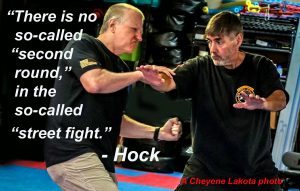
“There is no second round in the street,” might be an old and corny expression for some, but some folks need to hear it once, or once in a while, to get them back on track for what they want, and what they are forced to do in classes and programs.
Attrition is defined as – “the action or process of gradually reducing the strength or effectiveness of someone or something through sustained attack or pressure.” It’s a word used in military battles and war, and here in sport fighting “physical attrition” is a strategy.
In sports, it is indeed the coaches job to map out a strategy to your first or next fight, give you a game plan. You know that in amateur and pro fights, where a history and film exists on your next opponent, these histories are studied and strategies evolve. A properly prepped, fighter, MMA, BJJ, UFC or otherwise needs to walk in with a strategy, a plan. And in this process, the plan is made and you might hear from your coach, “Do this, then do this and this, and the fourth round is yours.” “You…make your move,” Kind of talk. Or ideas about tiring him out in among the battle plan. “First round? Check him out, probe. Probe with the jab. See how he reacts. Second round do ‘this or that’ with the discoveries from your probing. Third round is yours, as you will…”
Coaches say – tire him, move around, also deliver body shots too and kicks too in kickboxing, to weaken and confuse the opponent in round one and round two for the theoretical victory in Round 3.
In one example of body shots, there were numerous successful (and unsuccessful) boxers who spent rounds pounding the upper arms of their opponents so that eventually their guard, through multiple rounds, would eventually drop, their beaten arms down for their eventual, head shots, so that the… ” ______ (fill in the blank) round is yours.”
I think it would be odd for a coach to simply say, “knock him cold with a head shot in the first two seconds. That is all. Now go jog and hit that bag.” Fighters do indeed knock people out quickly, but aren’t they always handed an overall, planning, staging, strategy, etc.? Despite the delaying plans, bingo!
For many fighters, this plan is laid out in the first meeting for training for a specific fight. This fighter then and quite possibly gets this message buried in his head for months, “Third round is mine. Third Round is mine.” Even in the first round, he is fixated on the third round, deep in his head.
This type off delay-progression, advice was advice I had been given for decades by various boxing, kick boxing, and even Thai boxing coaches.
The transition of these delay ideas and advice can get blended over and into, for lack of a better term, “self-defense-street-fighting” courses. Training by short-sighted, self defense course trainers and coaches can, have and will get these borders confused. I was told these off-mission tips at times in several self defense courses that included boxing, kickboxing and Thai methods. For examples:
The “who, what, when, where, how and why” questions arises again.. Briefly, as these questions run deep…
I called these off-mission, missteps – “sport cancers” to be on the lookout for in all transitions from sports to the non-sports world. This is actually quite hard to dissect, especially buried within small steps. Even after 40 years I STILL spot things that I, or we, should not be doing. Enlightened coaches look for these, but I must tell you I don’t find many such enlightened coaches. Many are so immersed in what they do systemically, via their mindset, via hero or system worship or franchise dues, they will not or can’t detect the discrepancies and will not or cannot rebel against them.
“There was no second or third round in the street fight,”…to use a corny phrase. These street fights/arrests I was in and ones I had to break up and later investigate had little time for the experimental probing jabs, trick footwork or secondary blows to wear an opponent down through time, and other “second-third-or-more round,” ring sport, strategies.”
Upon self-examination, be happy with what you do and know why and what you are doing. I want you to be happy in your pursuits.
Physical attrition. We don’t have time for physical attrition. I hate to use the over simplistic term “street fight” because real encounters occur inside and outside of homes and businesses in rural, suburban and urban locations. But these so-called “street fights” were almost always hard, fast, crazy and over quickly. You were bum-rushed, or wild-man-tackled and, or sucker-punched, hit with chairs and lamps, etc…I was attacked once by a man with a big ax. No time for several probing, experimental sport jabs versus the swinging ax man.
Hock’s email is HockHochheim@ForceNecessary.com
^^^^^^^^^^^^^
Get this Training Mission One book here
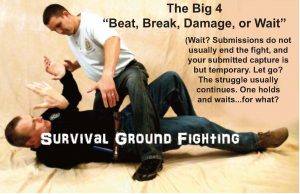
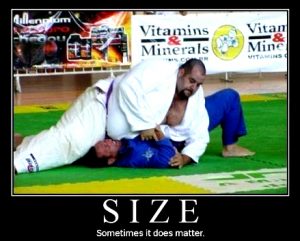
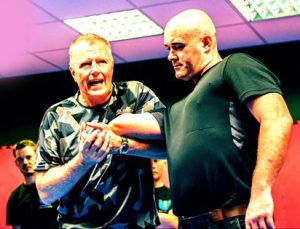
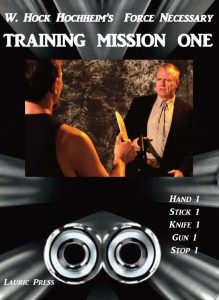
“Harvey … give me the shotgun, or ELSE!” (and other Harvey tales.)
That was the time when cops usually got killed, I reminded myself, looking at an angry Harvey Wilson with a 12-gauge pump aimed at me. But I thought since I knew him, I could talk him down … I thought….
The first time I met Harvey Wilson, he was drunk riding a horse. Not too unusual since, after all, it was Texas. It was a bitter cold winter night, about 2 a.m. back in the 1970s; and Garry Burns and I were on patrol when we spotted Harvey slumped over the saddle. Harvey had a barn on the back of his one-acre lot with a house in the city limits, and apparently this horse didn’t know the way home to the barn. Or it was on a walk, and Harvey was just there bouncing along for the ride. We coasted up beside the horse and rider.
“Harvey!” Garry shouted.
No answer.
I pulled up far enough ahead that we both could get out.
The old horse walked up to us. We grabbed the reins and stopped the gelding.
“WHAT?” Harvey snapped awake when the horse stopped. “What!” and then started kicking at us.
Harvey was a hard-working stout, black man in his late 50s at the time, living alone in a neighborhood of welfare cases, drug addicts, screw-ups, and fuck-offs. Harvey was a little rowdy and tended to “pull the cork”; but despite the whiskey, he was always at work the next day. That night he fussed and kicked at us enough that Garry decided Harvey needed to spend four hours in our urine-and puke-stained, stinking drunk tank. In other words, he was arrested for “drunk in public.”
We hauled him off the horse and cuffed him in a frisky little wrestling match, all under the big eyes of his calm horse. I put Harvey in the front seat; back then in the pre-cage days, that was where we transported prisoners so we could watch them as we drove. Garry got in the driver’s seat, and I climbed up into the saddle. I rode the horse to the city animal pound while the dispatcher paged out the on-call animal pound worker to meet me there.
Not six months later and alone this time, I repeated the whole drunk-on-a-horse affair again with a smashed and frisky Harvey. If you looked at Harvey’s file, you’d find multiple drunk-in-public arrests. Still, he never seemed to hold a grudge and always held down a job. On weekends you’d drive by his small wooden house; and he would be painting, or cementing, or fixing something. Salt of the Earth. Every once in a while when I was on Saturday or Sunday day shift, I would pull over and get out to talk with him for a few minutes.
“Whatcha’ doing, Harvey?”
“Ohh … oh, fixin’ to clean out my septic tank lines,” he would say softly and breathlessly and rest on a shovel and tell me the symptoms and cure for his latest housing ailment. When he was sober, he was just a fine person.
Then I happened to notice a fairly new red Camaro started appearing; it was parked on the street outside Harvey’s house. One day I saw a very attractive black girl, say in her late 20s or early 30s, pulling up in it and walking into Harvey’s house with her arms full of shopping bags. She entered without knocking. The car remained there night after night. I asked Marvin Hayes, a retired postal worker and a neighbor down the street, about this mystery car and curvy girl.
“Harvey’s got him a girlfriend. YaHeah! And I means to say girl! Young! She’s a sweet young thing, too. From Dallas. I don’t know how they met. And I don’t know how he keeps her. But he bought her dat dere car, you know?”
“NO!” I declared. “The Camaro?”
“Yes, he did. Bought her dat car and, and jewelry, and, and I don’t know what all. YaHeah! I hopes he knows what he is a doin’. Cause you know, this kind of business don’t end well.”
You can say that again. I ran the license plate of the car in the hopes of getting her name and seeing if she had a criminal history. The plate was still registered to a car dealership in Dallas. Back then it used to take a while, maybe even a few weeks, to catch registrations up on NCIC.
In our squad meetings, the sergeant read us the daily blotter each day, the list and quick summary of the events since we left the day before. Over a period of three weeks, there were several domestic disturbance calls at Harvey Wilson’s house. There was already trouble in paradise. I never caught a single one of those domestic calls at Harvey’s house until one Saturday afternoon.
Neighbors reported another fight. When I pulled up, that girl was almost through packing her Camaro. She looked up and smirked at me and continued yelling over her shoulder at Harvey, who was up the small hill of his front yard and by his front porch. When I climbed the small incline, I got my first full, look at Harvey. He was holding a pump shotgun at port arms. His eyes were red and wet, and the veins and muscles in his neck bulged. I knew if I drew my pistol, that action could be a catalyst for him to react and shoot me or her, or both of us. I could just tell. And that is how many, if not most, cops are killed in domestics. Thinking about these things. Feeling them. It’s a gamble.
“I’ll kill her!” he yelled.
“Harvey. Put down the gun. You can’t kill anybody,” I said.
“BITCH! I’ll kill you, BITCH!” he yelled. He was barely paying attention to me and watching her pick up her suitcases from the lawn.
“I bought that car!” he said.
“It is in my name, mutha-fucka!” she yelled.
He pointed his gun at her. My thumb undid the snap of my holster, and I grabbed a handful of my pistol handle. I did not draw the gun yet.
“Harvey. Harvey. Harvey,” I repeated calmly. “You can’t kill her. You can’t kill her over a car. You know that. Give it up man. You can’t be doing that. Put the barrel down. Let her go. You shoot her, and your life is over. She ain’t worth it!”
I inched closer and closer, and he got madder and madder. He was losing it. He waved the gun over to me, inches from fully lifting the stock to his cheek and shooting.
He glared and gritted his teeth, and I could see his fingers moving in waves on the gun. The barrel wandered from me to the girl, then to no one, and back again. During a wander, I got close enough to lunge out and grab the weapon with both my hands and pulled the barrel up and the stock down. With a motion not unlike rowing a double oar of a canoe, I ripped and rolled the gun from his grip.
The girl slammed the car door and burned rubber down the street. Harvey’s little temporary paradise … was gone.
I ran the pump up and down, which spit out the shells across the manicured lawn. When it was empty, I laid it against a porch railing. Harvey sat on the stairs of the porch. I sat down next to him. Marvin had witnessed the whole thing from next door and walked over. He was probably the one who called us.
“Man! Fuck!” Harvey said. “Did I get fucked?”
“She was no good,” Marvin said. And I agreed.
We sat there on the steps for about 10 minutes talking. My backup squad car drove up and stopped. I waved him off, signaling it was all over and everything was okay.
I got up after a bit and said, “Harvey, I am gonna take this shotgun in with me for 24 hours.” I saw Marvin nod his head at me. “You can come down to the station and get it tomorrow.” I picked up the ejected rounds on the manicured grass.
“You got him, Marvin?” I asked.
“I got him. I got him,” Marvin said.
We used to have a policy where we would extract guns from a hot situation where there might be more violence or suicide and lock them up at the police department. Just a local practice. The owner would have to go see the police chief and talk to him and retrieve the gun. And, Ol’ Harvey did just that. He picked up his gun the next day after Chief Hugh Lynch had a word of advice or two for him. Harvey remained quiet and behaved himself with the ladies from then on.
One morning some 10 years later, when I was a detective; and we got a call of a body found near some undeveloped land in the southeast part of town. A cable man and a railroad agent were surveying land to bury some lines near a run of tracks when they stumbled upon a body not that far from the road. It was not uncommon to instinctively dispatch an ambulance to a body like this, and the dispatcher did.
When I got there though, I was surprised to find EMTs feverishly at work at the scene. The railroad man walked up to me and said, “He wasn’t dead! We thought he was dead, but he wasn’t.”
I walked past the agent and to the action. The techs were working on Harvey Wilson! Harvey was dressed up in a suit and looked like he was pulverized to a pulp. He was whisked to the hospital and lay there in intensive care for days in a coma.
I went to Harvey’s house, and Marvin and I tried to reconstruct his last healthy day. One thing for sure, Harvey’s pickup was missing; and I put out a “BOLO” on the truck. We searched his house and found his insurance papers; and through a local agent, we confirmed the license plate number. I was frozen stuck in a bad, violent case with no leads, conjuring a range of hypotheses, and hoping the truck would show up somewhere, or Harvey would just wake up.
The hospital called days later. A nurse said Harvey was up and trying to eat. You know where I went, straightaway.
“What happened, Harvey?” I asked him.
“John Wayne Williams. He asked me for a ride. Then he pulled a gun on me. That skunk fuck. He made me stop the truck out there on Morse Street. He beat me up with his gun and robbed me. Left me for dead meat in the woods. I thought I was gonna die.”
John Wayne Williams. Local gangster. We’d gotten word of his recent parole, and you could bet how long before he would be in violent trouble again. It was that inevitable. And he was indeed a skunk fuck. I got a probable-cause, arrest warrant for Williams, and Danny McCormick and I hunted around day and night, and found him in about two days. He was a muscular, 6 feet 6 inches of smartass ex-con; and when we spotted him in a housing project, parking lot, we both drew down on him with our .45s in case he still had that pistola and to avoid going hand-to-hand with that big bastard. We ordered him on his knees with his hands up and cuffed him quick. He did have a pistol on him. Instant legal trouble for a parolee.
At the station Danny and I interrogated him. He played dumb. We never found that truck. In those days, vehicles were easily stripped and sold for parts in chop shops either out in the county or in Dallas or Ft Worth. But with Harvey’s testimony, I sent him up for the “big bitch (life,)” as this was his third felony. Third time was a bad charm In Texas.
Harvey was never quite the same after that near-death beating. Within a year thereafter, he died of natural causes. Heart attack. One of his kids drove in from Oklahoma and sold the house. New folks lived there quickly. Then Marvin, the old postman died too. After awhile, when you work in a city, so many houses, street corners and buildings, whatever, where ever, you have a memory attached to them when you see them. Places. People. Usually bad memories. I try not to visit my old city anymore, for that reason. Way, way too many bad memories.
***************
Hock’s email is HockHochheim@ForceNecessary.com
For more of these police tales, get these books. Paperback or e-book. Click here.
I can’t say how old this list is. I saw them all in the 1970s in police training. This list. It’s not in any order.
The list was distributed in a police-only textbook in 1975 called Officer Down, Code 3, by Pierce Brooks. The list also applies to the military. One might think that this doesn’t completely apply to citizens? But it does. For example, some civilians might think that Number 9 doesn’t apply, but there are situations, concerns and applications about controlling suspects while waiting for police arrival. I have taught those “arrest, control and contain” methods for over 26 years to people because I think they need to know them. They can be important. I have always said,
“I’ve never learned anything as a cop I didn’t think citizens needed to know too.”
If a person will stop and think about it, every point can apply to their safety.
Many of you out there think some of these topics are “new” and recently invented by young “geniuses.” Like the pre-fight indicator lists which has reached new fad-like heights of late. None are new. I do think they have some merit as I have seen them unfold before my eyes. But they are not as important as one might think when you add criminal and military ambush into the equation. But the police spend an inordinate amount of time intervening, interviewing, investigating and prowling into areas regular people shouldn’t do or go and interacting with people. So too do soldiers and Marines going to house-to-house, village-to-village in the last 20 years. Knowing these, essentially biological tip-offs and learned tricks like sucker punches and so forth, can be helpful. I have a while chapter of these pre-fight tips in my book, Fightin’ Words. I started collecting them in 1973 from a class in U.S. Army military police academy.
Numerous tips are instinctual for many, but the list attempts to stick a label on it – which is fine and can be educationally important. New people are learning old stuff all the time and “old,” “been-around” people need reminders, maybe through new ways (as well as learning new things too).
People are constantly ridiculing police actions and police training. The root, the backbone, the steering for quality has been present for decades and decades. Apathy, manpower and budget problems get in the way. It’s left to the individual officer to spend, train or to stagnant. As with a citizen. Learn, train or stagnate. Use it or lose it. Ignorant and or, Perishable.
People – cops, may tire of seeing the list and their eyes might brush right over the poster in a blur after awhile, as it appeared on many a squad room wall decades ago. All of the “fatal mistakes” are important. All are old pieces of advice you can live or die by. May all good people live by them.
Get these combatives books, Hardcover, Paperback, Kindle, E-book, click here
Messing around with Judo, working out with friends, watching judo practice and tournaments, studying the stepping and positioning of opponents and the time it took, I once made a remark years ago in this class, that –
“all judo throws work quickly after you break the guy’s nose.”
And many friends looked at me like I was crazy or something. But I wasn’t. I meant it. You’ve seen grapplers step and step and torso-twist and circle arms for a position for a take down. You’ve seen wrestlers, wrestle and wrestle to get that submission. But, once you severely stun the opponent, opportunities suddenly, can quickly occur in all forms of fighting, standing and on the ground.
Put boxing into judo. Put ground n’ pound into wrestling. Unarmed or with weapons, close and afar, once stunned, they are diminished to some degree.
Weapon worlds? Yes. Of course. Through the years in policing and training with Simunitions, and other sims ammo that goes “boom,” I have learned that he who gets that first gunshot off, sends not just a bullet but a very shocking explosion at the opponent, so often disrupting their return fire plans, especially when close. Most range shooters are never on the wrong end of a barrel and don’t grasp this tremendous “first shot” advantage. Why do you think the police and military use stun grenades? It’s a form of “bullet shock.” In short, the first guy does a desperate, sloppy draw and shoots, missing his opponent. The second guy squints, his cheeks flap, draws, shoots under this pressure-blast and he misses. And so goes the common formula. You wear hearing protection when you stand BESIDE a shooter. Try to imagine being right in front of one, with no “ears” on.
Many knife victims are more shocked at seeing a knife, than feeling it as many do not even know they were stabbed or slashed at first, reporting instead that they were lightly hammer-fisted or punched. Yeah. Look it up.
What exactly is the Diminished Fighter Theory? It’s just a helpful phrase I coined decades ago about how you need to diminish an opponent in a fight. This is far from a new idea, its common sense and most folks get it, but still the idea doesn’t often float down and melt into many systems and routine practice. It is not “written-up” in the mission-statement or outlined in doctrine. Many martial arts like to advertise that “this art is self defense too!” Well, not really. Abstract yes. Helpful? Probably. But what is your real mission? Hobby? Tradition? Exercise? Sport? All four? The “What” question. Are you all over-over-the-board and don’t know it? (I confess that I spent many a decade all-OVER-the-martial-arts-board, minus proper definitions and direction. It was NOT a waste of time, just abstract.)
I report this here after over 40 years in the martial arts and 26 years in line operations in law enforcement, bodyguarding and investigations, whereupon I have arrested some 900 people. Some of these people were very “cranky” on up to a rare few that tried to kill me. So, I hope what I suggest here gets your attention. This is not just about simple martial arts “punching.” This theory is about hand, stick, knife, gun, crime and war, inside and outside structures on rural, suburban and urban areas.
We fight enemy soldiers, criminals and “drunk uncles” (family and friends). Sometimes they come to you already diminished. They are drunk, drugged, out-of-shape, untrained, etc. Sometimes, not. Once in front of you and things get physical, then, when we have to fight their…
We fight an opponent’s athleticism, their pain tolerance and their adrenaline, and with these elements even the lesser performer might still rise beyond our expectations.

“Punch a black belt in the face once, he becomes a brown belt. Punch him again, purple….” – Carlson Gracie Sr.
Levels of Stun: Levels and forms of stunning doesn’t just happen from a “punch,” a slap, a flash of a knife, or a close gunshot, and-or explosion. Stunning and subsequent diminishment is in any good ambush, wall slam or a takedown-throw when then the opponent first crashed to ground zero. And, I might quickly add here that you or your opponent may quickly “run out of gas,” another form of common diminishment, something that “emotional control and pacing” can help you with. There are indeed methods to enhance these things. Also, with this acknowledgement, you must include methods that “prepare for, and recovery from… stunning” in your lesson plans. It is tough recovering from a total ambush, but there are otherwise, “steeling yourself” methods. That’s another topic. It’s all part of my oldest motto, “Expect chaos. Train for chaos. Thrive in chaos.”
Officially recognize and place this diminished fighter concept )big and up front) in your martial training, and your martial arts training. There are many connected subjects to this topic I write about and teach through the Stop 6 course and the vital blueprint of the Who, What Where, When, How and Why (Ws &H) questions. This is just a quick slice.
_________________________________
Hock’s email Hock@hockscqc.com
Get these streaming download videos…